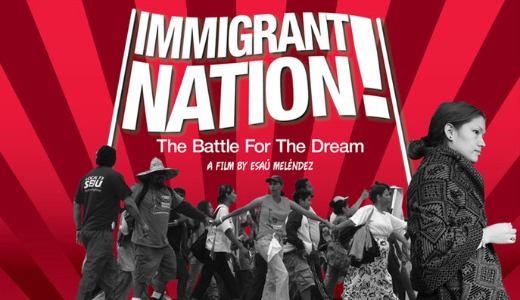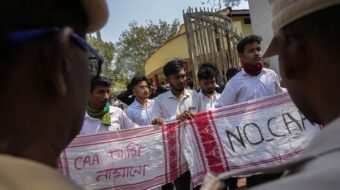
Movie Review:
Immigrant Nation! The Battle For The Dream
Directed By Esaú Meléndez
2010, Documentary, 96 mins.
The new documentary Immigrant Nation: The Battle for the Dream is a powerful and extremely moving film. It highlights the recent and historic immigrant rights movement that swept the nation beginning in Chicago on March 10, 2006. One aspect of the film emphasizes the pain, suffering and tears of U.S.-born children of immigrants whose families have been torn apart by the country’s broken immigration system. But more than anything else, this documentary demonstrates the courage and spirit of immigrant activists that took matters into their own hands in the fight for their basic human rights and comprehensive immigration reform.
Directed by Esaú Meléndez, the film begins with immigrant rights activist Elvira Arellano recalling the day immigration officials raided her home in 2002.
Arellano, originally from Mexico, tried entering the country but was deported. She managed to re-enter and began to make a life for her and her U.S.-born son before she was arrested in 2002. She decided to fight for her, and especially her son’s, right to remain in the country. After a three-year court battle and despite years of her community activism, Arellano was ordered deported.
Through her Chicago-based organization Arellano made national headlines in 2006 when she defied the deportation order and sought sanctuary at her church. The film follows Arellano’s personal story and her eventual return to Mexico.
The film also recalls the sleeping giant that first rocked Chicago, then the entire nation, in the spring of 2006 after HR 4437, also know as the Sensenbrenner bill, was passed in the House. The draconian bill, which failed in the Senate, would have largely criminalized every aspect of the estimated 12 million undocumented immigrants living in the country.
It began in Chicago, where more than 700,000 immigrant rights activists took to the streets in protest of HR 4437 on March 10, 2006. And later that spring on May 1, known worldwide as International Worker’s Day, millions of unionists and immigrant activists joined together in major cities nationwide to march in droves for comprehensive immigration reform.
Authors, immigrant rights leaders and activists are featured in the film. Many note the movement was essentially centered on the rights of working people and immigrant communities who came to the U.S. in search of work and a better life for their families. Critics say free trade pacts, especially NAFTA, is largely to blame for the millions who were displaced and headed north, seeking employment in the U.S.
Of the many aspects noted in the film, the most touching are the voices and faces of children forced to cope with the fact that their families have been torn apart after being separated from their immigrant parents.
Meléndez, an independent filmmaker, is originally from Mexico and now lives in Chicago. He said he was inspired to make the film after witnessing thousands of people that marched in the streets for immigrant rights.
“It all started on March 10. The amount of people was one thing, but the energy was incredible and really demonstrated a time when people really wanted to stand up and speak out,” he said.
He said he was tired of how the immigrant rights movement was being explained by the mainstream media, which gave a lot of airtime to right-wing conservative anti-immigrant groups like the notorious Minutemen.
“Arellano also represented what we were all fighting for – direct action. And she made the biggest sacrifice for the movement and became the symbol for our cause,” said Meléndez.
While making the film, Meléndez said, he believed immigration reform would follow the 2006-midterm elections after Democrats won a majority in both the House and Senate. These victories and the hopes for reform by the immigrant rights community are portrayed in the movie.
“Today we don’t know what will happen,” says Meléndez, referring to the fact that although Democrats are still a majority in the Senate, the Republicans have won back the House.
Even with President Obama in office, it’s been very difficult, said Meléndez. But victory is still possible if Obama is re-elected for a second term.
In order to really make a difference, we need our communities to make their voices heard at the ballot box and elect leaders that will fight for the immigrant community, says Meléndez. People need to be informed about the importance of voting and getting involved and staying involved, he said.
As an independent filmmaker, he said, producing the film was very challenging especially when it came to gathering funds from the industry’s major donors. He said he was turned down several times by those who said his film “was not objective and too much of an advocacy piece.”
Having limited financial resources to make such films that are about minorities, by a minority and for minorities was not easy, says Meléndez.
He notes, “Latinos only represent about 2 percent in the mainstream media, yet according to latest figures we’re about 20 percent of the population.”
Go to the films website to order a copy. www.Immigrantnationfilm.com.
Photo: www.Immigrantnationfilm.com.












Comments